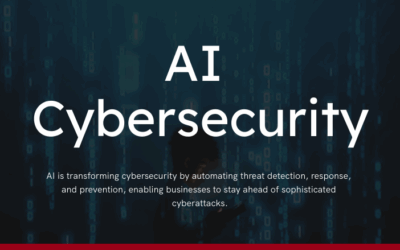The cybersecurity landscape in 2025 is undergoing a significant transformation, driven by the rapid advancement of technologies and the ever-growing sophistication of cyber threats. As organizations and individuals face increasingly complex challenges, innovative solutions are emerging to address these risks. This article explores the latest cybersecurity technologies, trends shaping the industry, and data-driven insights to highlight the critical role of innovation in staying ahead of cyber adversaries.
The Current State of Cybersecurity in 2025
Cybersecurity has grown into a $300 billion industry, according to Statista, driven by escalating cyberattacks targeting businesses, governments, and individuals. The average cost of a data breach reached $4.6 million globally in 2024, according to IBM’s Cost of a Data Breach Report, underscoring the financial stakes at play. Meanwhile, a study by Cybersecurity Ventures predicts global cybercrime damages will exceed $10.5 trillion annually by 2025, making cybersecurity one of the most critical areas of investment for organizations worldwide.
Key Industry Stats in 2025:
- Ransomware attacks have increased by 67% over the past three years, with targeted attacks on critical infrastructure rising sharply.
- Zero-day vulnerabilities have surged by 60% year-over-year, as threat actors exploit unpatched systems and legacy software.
- Artificial intelligence (AI) adoption in cybersecurity has grown, with 75% of enterprises leveraging AI-powered tools for threat detection.
With these challenges in mind, let’s explore the innovative technologies reshaping the cybersecurity landscape in 2025.
Key Cybersecurity Technologies in 2025
1. AI-Powered Threat Detection and Response
Artificial intelligence (AI) is a game-changer in modern cybersecurity. Leveraging machine learning (ML) algorithms, AI-driven tools analyze vast amounts of data in real-time, identifying threats with unprecedented accuracy.
How AI Enhances Cybersecurity:
- Behavioral analytics: AI systems monitor user behavior to detect anomalies, such as unusual login patterns or unauthorized access attempts.
- Predictive analysis: Machine learning models predict potential vulnerabilities by studying past attack patterns.
- Automated incident response: AI enables faster responses to breaches by automating tasks like isolating compromised systems.
Example in Action: The emergence of AI-powered platforms like Darktrace and Cortex XDR has allowed companies to reduce threat response times by up to 96%. Additionally, businesses report a 40% improvement in attack detection accuracy using AI-based systems compared to traditional tools.
2. Zero-Trust Architecture (ZTA)
The zero-trust security model is no longer optional—it’s a necessity. With the rise of hybrid workforces and cloud adoption, perimeter-based defenses have become obsolete. Zero-trust assumes that no user or device is inherently trustworthy, enforcing strict access controls and continuous verification.
Core Principles of ZTA:
- Least privilege access: Users are granted only the permissions they need to perform specific tasks.
- Micro-segmentation: Network segmentation reduces the attack surface by isolating critical assets.
- Identity verification: Multi-factor authentication (MFA) and biometric verification are integral to zero-trust strategies.
Adoption Trends: By 2025, over 85% of large enterprises have implemented some form of zero-trust architecture, according to Gartner. This approach has been especially impactful in reducing insider threats, which account for 25% of all data breaches.
3. Post-Quantum Cryptography
As quantum computing becomes a reality, traditional encryption methods like RSA and ECC are at risk of becoming obsolete. Post-quantum cryptography (PQC) is designed to withstand the computational power of quantum computers, ensuring secure communications.
Key Developments in PQC:
- NIST standards: In 2024, the National Institute of Standards and Technology (NIST) finalized its first set of quantum-resistant encryption algorithms.
- Hybrid encryption: Organizations are adopting hybrid approaches, combining classical and quantum-safe encryption methods during the transition period.
Market Impact: The PQC market is projected to grow at a CAGR of 20% between 2024 and 2030, as companies future-proof their systems against quantum threats.
4. Secure Access Service Edge (SASE)
SASE combines network security and wide-area network (WAN) capabilities into a single, cloud-delivered service model. This architecture simplifies security for distributed workforces while enhancing visibility and control.
Benefits of SASE:
- Unified security stack: Integrates VPN, firewall-as-a-service (FWaaS), and secure web gateways.
- Improved performance: Reduces latency by routing traffic through optimized cloud points of presence (PoPs).
- Scalability: Ideal for dynamic environments where employees access corporate resources from various locations.
Industry Usage: By 2025, 451 Research estimates that 60% of enterprises will have transitioned to SASE, driven by its ability to secure hybrid and multi-cloud environments effectively.
5. Extended Detection and Response (XDR)
Building on traditional endpoint detection and response (EDR), XDR extends threat detection across multiple vectors, including endpoints, networks, servers, and email.
XDR vs. EDR:
- Comprehensive coverage: XDR provides holistic visibility into the threat landscape, unlike EDR, which focuses solely on endpoints.
- Proactive threat hunting: XDR correlates data from various sources, identifying sophisticated attacks earlier.
Market Growth: According to Forrester, the XDR market will surpass $5 billion by 2025 as organizations adopt this technology to streamline their security operations centers (SOCs).
6. Biometric Authentication and Passwordless Security
Passwords remain a weak link in cybersecurity, accounting for 81% of hacking-related breaches, according to Verizon’s Data Breach Investigations Report. In response, biometric authentication and passwordless systems are replacing traditional credentials.
Examples of Emerging Solutions:
- Facial recognition: Devices like Apple’s Face ID and Microsoft’s Windows Hello are setting the standard for secure, seamless access.
- Behavioral biometrics: Systems analyze typing patterns, mouse movements, or device usage to verify identity.
- Passkeys: Tech giants like Google and Apple are championing passkeys, enabling secure logins using public-key cryptography.
Adoption Trends: A survey by Deloitte indicates that 70% of organizations plan to implement passwordless authentication within the next two years, improving both security and user experience.
The Role of Cybersecurity Analytics in 2025
Data analytics plays a pivotal role in shaping cybersecurity strategies. By harnessing advanced analytics, organizations can identify patterns, assess risks, and make informed decisions.
Key Applications of Analytics:
- Threat intelligence: Aggregating data from multiple sources to gain actionable insights into emerging threats.
- Risk assessment: Quantifying vulnerabilities to prioritize remediation efforts.
- Compliance monitoring: Ensuring adherence to frameworks like GDPR, HIPAA, and CCPA.
The Rise of Predictive Analytics
Predictive analytics tools use historical data to forecast future cyberattacks. In 2025, 42% of organizations utilize predictive analytics, reducing incident response times by 30%.
Emerging Trends and Innovations in Cybersecurity
While 2025 has brought cutting-edge developments in cybersecurity, many technologies and approaches have been evolving steadily over the past decade to address persistent challenges. Beyond the innovations already discussed, there are several trends and methods gaining traction in the fight against cybercrime. These advancements reflect a broader understanding of the ever-changing threat landscape and emphasize the importance of adaptability, resilience, and collaboration.
1. The Rise of Cybersecurity Mesh Architecture (CSMA)
As organizations embrace distributed environments, cybersecurity mesh architecture has emerged as a solution for modern network challenges. Traditional, centralized security frameworks are often ineffective for today’s decentralized infrastructures, particularly as businesses adopt multi-cloud strategies and hybrid work environments.
What Is CSMA?
CSMA is a scalable, modular approach to cybersecurity that treats security as a cohesive ecosystem rather than a single, monolithic solution. It integrates disparate security tools, ensuring they work together to provide consistent protection across all systems.
Benefits of CSMA:
- Unified visibility: Organizations can monitor and manage security across cloud, on-premises, and remote environments from a central interface.
- Improved agility: CSMA enables businesses to quickly adapt to emerging threats without overhauling their entire security framework.
- Reduced downtime: By connecting security tools, CSMA improves response times and minimizes operational disruptions caused by cyber incidents.
Adoption Insights: A report from Gartner predicts that by 2026, organizations implementing CSMA will reduce the financial impact of security incidents by an average of 90%, demonstrating its effectiveness as a proactive cybersecurity measure.
2. Threat Intelligence Sharing
Collaboration is becoming an essential component of effective cybersecurity. No single organization or agency can combat the increasing complexity of cyberattacks alone. Threat intelligence sharing—the exchange of information about cyber threats, vulnerabilities, and attack methodologies—has become a powerful strategy for enhancing collective security.
How Threat Intelligence Sharing Works:
- Public-private partnerships: Governments and private organizations collaborate through platforms like the Cybersecurity and Infrastructure Security Agency (CISA) and Information Sharing and Analysis Centers (ISACs).
- Automated sharing protocols: Technologies like STIX/TAXII (Structured Threat Information Expression/Trusted Automated Exchange of Intelligence Information) allow for standardized and automated threat data exchange.
- Global alliances: Initiatives such as FIRST (Forum of Incident Response and Security Teams) and Interpol’s Cybercrime Knowledge Exchange Workspace facilitate cross-border collaboration.
Benefits:
- Early warning systems: Shared intelligence helps detect emerging threats before they escalate into major attacks.
- Improved defenses: Organizations can learn from the experiences of others and adopt proven strategies to protect their own systems.
- Reduced duplication of effort: Collaborative efforts ensure resources are used efficiently, with less redundancy.
Example: In 2022, the healthcare sector saw the successful implementation of threat intelligence sharing when hospitals worldwide collaborated to counter ransomware attacks. By identifying common attack patterns, they were able to strengthen defenses and reduce successful intrusions by 50%.
3. IoT and OT Security
The proliferation of Internet of Things (IoT) devices and Operational Technology (OT) systems has dramatically expanded the attack surface for cybercriminals. As IoT adoption continues to grow, securing these interconnected devices is critical to prevent widespread disruptions and data breaches.
IoT Security Challenges:
- Vulnerable endpoints: Many IoT devices lack robust security measures, making them easy targets for attackers.
- Botnet threats: Cybercriminals often use compromised IoT devices to build botnets for launching distributed denial-of-service (DDoS) attacks.
- Supply chain risks: Weak links in the IoT manufacturing and supply chain can introduce vulnerabilities across entire networks.
Key IoT Security Solutions:
- Device authentication: Ensuring only authorized devices can connect to networks.
- Firmware updates: Regular updates to patch vulnerabilities in IoT software.
- Network segmentation: Isolating IoT devices from critical systems to minimize damage in case of a breach.
Operational Technology (OT) Security: In industrial environments, OT systems like SCADA (Supervisory Control and Data Acquisition) and ICS (Industrial Control Systems) are increasingly being targeted. Cyberattacks on these systems can disrupt manufacturing processes, energy grids, and even public safety. Implementing security measures such as network segmentation, access control, and intrusion detection systems is crucial for safeguarding OT infrastructure.
4. The Evolution of Ransomware Defense
Ransomware remains one of the most pervasive and damaging forms of cybercrime. By 2025, ransomware attacks are expected to cost organizations worldwide over $20 billion annually, according to Cybersecurity Ventures. To counter this growing threat, both technology and strategy are evolving.
Advanced Ransomware Tactics:
- Double extortion: Attackers not only encrypt data but also threaten to leak sensitive information unless a ransom is paid.
- Ransomware-as-a-service (RaaS): Cybercriminals sell or lease ransomware kits to other attackers, democratizing the ability to launch sophisticated campaigns.
- Targeting backups: Modern ransomware targets backup systems to prevent organizations from restoring data.
Emerging Defense Strategies:
- Immutable backups: Storing backups in a way that prevents them from being modified or deleted by ransomware.
- Endpoint protection platforms (EPP): Advanced tools that detect and neutralize ransomware before it can execute.
- Ransomware insurance: Businesses increasingly rely on insurance policies to mitigate financial losses from ransomware incidents.
Real-World Success:
Companies adopting a combination of endpoint protection and ransomware-resistant backups report a 70% reduction in downtime following attacks, according to a study by Ponemon Institute.
5. Decentralized Identity Solutions
Traditional identity management systems rely heavily on centralized databases, which are often targeted by cybercriminals. A single breach can expose millions of user records. Decentralized identity solutions, powered by blockchain technology, offer a more secure alternative by giving users control over their own identities.
How Decentralized Identity Works:
- Users store identity credentials on a secure, blockchain-based platform.
- Authentication is achieved through cryptographic proofs rather than username/password combinations.
- Organizations can verify identity without directly accessing sensitive user data.
Benefits:
- Enhanced privacy: Users can share only the minimum amount of information required for verification.
- Reduced attack surface: Decentralization eliminates centralized databases, making it harder for attackers to target identity systems.
- Greater user control: Individuals have full authority over their own identity data.
Adoption Trends:
Decentralized identity solutions are being explored by industries such as healthcare, finance, and e-commerce to enhance privacy and reduce fraud.
6. Behavioral Analytics for Insider Threats
While external threats like ransomware dominate headlines, insider threats remain a significant risk. Employees, contractors, and partners can intentionally or unintentionally compromise an organization’s security. Behavioral analytics tools use machine learning to identify unusual user activity, helping detect insider threats early.
Key Features of Behavioral Analytics:
- User and Entity Behavior Analytics (UEBA): Monitors baseline behaviors to flag anomalies, such as accessing sensitive files during odd hours.
- Risk scoring: Assigns risk scores to users based on their behavior patterns, prioritizing high-risk individuals for investigation.
- Real-time alerts: Alerts security teams when suspicious activity is detected.
Benefits:
- Proactive detection: Behavioral analytics can identify threats before they escalate.
- Reduced false positives: By focusing on context, these tools minimize unnecessary alerts.
- Enhanced compliance: Helps organizations meet regulatory requirements by detecting unauthorized access to sensitive data.
Stat Insight: A study by CyberEdge Group found that companies using behavioral analytics reduced insider threat incidents by 54%, saving millions in potential damages.
7. Cloud Security Innovations
As more organizations migrate to the cloud, securing these environments has become a top priority. Cloud security innovations are addressing challenges related to data breaches, misconfigurations, and compliance.
Emerging Cloud Security Solutions:
- Cloud-native application protection platforms (CNAPPs): Provide end-to-end security for cloud workloads, including application runtime protection and vulnerability scanning.
- Cloud access security brokers (CASBs): Act as intermediaries between users and cloud services, ensuring compliance and enforcing security policies.
- Encryption everywhere: Advances in encryption technologies ensure that data remains protected both at rest and in transit, even in shared cloud environments.
Multi-Cloud Security:
Organizations using multiple cloud providers face additional challenges, such as inconsistent security policies. Unified multi-cloud security platforms help ensure that data and applications are protected across all environments.
8. Cybersecurity Awareness Training
While technology is crucial, human error remains a major cause of breaches. Effective cybersecurity awareness training can reduce risks by empowering employees to recognize and respond to threats.
Components of Modern Training Programs:
- Phishing simulations: Interactive exercises that teach employees to spot phishing emails.
- Role-based training: Customized programs tailored to the specific security needs of different job roles.
- Gamification: Using games and rewards to make training engaging and memorable.
Effectiveness:
Companies with robust training programs report a 70% reduction in phishing-related breaches, according to a report by KnowBe4.
Challenges in Adopting New Cybersecurity Technologies
While the innovations discussed above offer significant benefits, organizations face several challenges:
- Skill gaps: The global cybersecurity talent shortage remains a barrier, with over 3.4 million unfilled positions worldwide.
- Cost constraints: Advanced technologies like AI and PQC require substantial investment, making them inaccessible for smaller enterprises.
- Integration issues: Legacy systems often lack compatibility with modern tools, complicating deployment.
Future Outlook: What’s Next for Cybersecurity?
The next wave of cybersecurity innovation will likely focus on:
- Decentralized security models: Blockchain-based systems for secure identity management and data sharing.
- Autonomous cybersecurity: AI-driven systems capable of operating independently to counter threats in real time.
- Cyber resilience: Strategies to ensure business continuity, even in the face of successful attacks.
With the cybersecurity industry poised to reach $400 billion by 2030, the emphasis on innovation and adaptation will only grow.







